Cotton is mainly grown for its fibre, known as lint. The quality of lint primarily depends on the cultivation methods. However, this quality can sometimes be compromised by diseases in the field, especially fungal diseases in cotton. What are some of the important fungal diseases in cotton that affect yield and quality?

Fusarium Wilt in Cotton
Fusarium wilt is a common fungal disease that affects a wide range of plants, including tomatoes, peppers, eggplants, melons, bananas, and not only cotton.
It is caused by the fungus Fusarium oxysporum. Fusarium Wilt starts when the Fusarium fungus reaches the soil. The fungus enters plants through their roots and travels up the stem. This fungus clogs the vessels, preventing water and nutrients from reaching the leaves, which then wilt and die.
Symptoms of Fusarium Wilt
Recognising Fusarium Wilt early is important as it can help in managing the disease. If you are observing stunted plants in the field, it might be due to fusarium wilt in cotton. The vascular system of infected plants is discoloured brown in affected portions of the tissue.
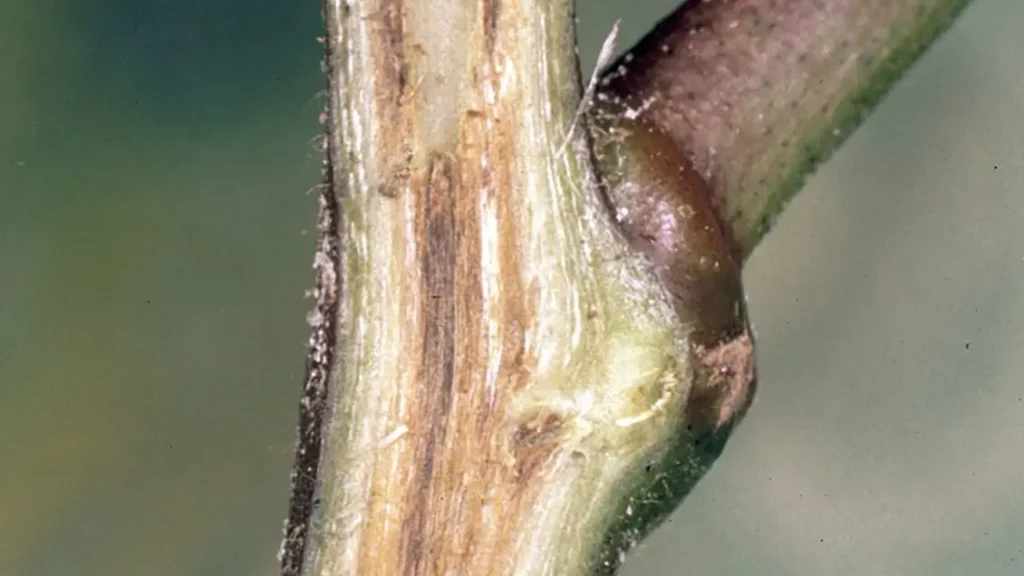
Here’s what to look for:
Wilting: This is a general wilt, often worse on hot days, and affects lower leaves first.
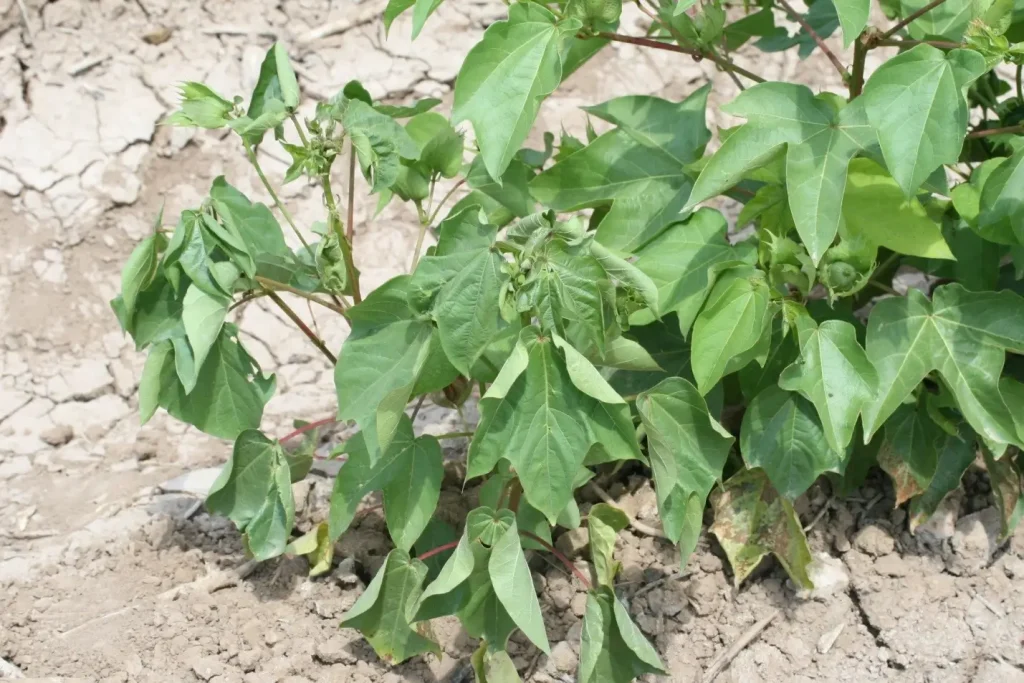
Leaf discoloration: Leaves will yellow and develop dead patches (necrosis) at the edges, progressing upwards.
Stunted growth: Affected plants will be shorter and less vigorous than healthy plants.
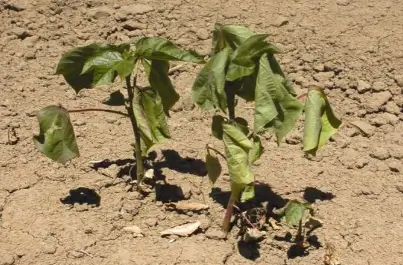
Early or patchy symptoms: Unlike some other diseases, wilt caused by Fusarium may appear early in the seedling stage or later during flowering. It can also affect individual plants or patches within the field.
Symptoms of fusarium wilt can appear at any stage of the plant’s life but are most common during the seedling phase and after flowering.
But how to know if it is fusarium wilt or verticillium wilt? To confirm Fusarium Wilt, cut the stem of the affected plant. If you see brown discoloration inside the stem tissues, it is Fusarium Wilt. This discoloration is different from Verticillium Wilt, which usually shows more small spots or patches of colour.
Several factors contribute to the spread of Fusarium Wilt:
Environmental Stress: Conditions like waterlogged soil, root damage from cultivation, and cool, wet growing periods can stress plants, making them more vulnerable.
Poor Farm Hygiene: The fungus spreads through contaminated soil, water and plant material.
How to manage fusarium wilt in cotton?
- Prevent waterlogging, over-fertilisation and avoid root damage by reducing inter-row cultivation.
- Isolate affected areas and manage irrigation to prevent spread.
- Keep crop residues on the surface for a month before incorporation.
- Prevent pathogen survival on non-host residues. Avoid green manure crops.
- Follow 3-year rotations with non-host crops like summer sorghum maize-fallow cotton to reduce disease and improve yields
Verticillium Wilt in Cotton
Verticillium wilt is another destructive fungal disease that affects cotton plants, caused by the soil-borne pathogen Verticillium dahliae.
The fungus Verticillium dahliae lives in the soil as dark, resting structures called microsclerotia. These microsclerotia germinate near cotton roots and infect the plant through tiny root hairs. Cool air and soil temperatures (around 18-24°C) favour the fungus.
Once inside the roots, the fungus colonizes the vascular system (water transport channels) of the plant. The fungus produces toxins and blocks the xylem vessels, hindering water and nutrient flow. As water transport is disrupted, leaves begin to wilt, showing yellowing between veins (interveinal chlorosis).
But how do we know, all this happening inside?
Are you observing interveinal yellowing of leaves on your cotton plants? Then it might be due to Verticillium wilt in cotton.
Symptoms of Verticillium Wilt
Wilting: Unlike Fusarium wilt, wilting in Verticillium wilt often appears later in the season, during flowering or boll formation.
Leaf Discoloration: Leaves show yellowing or bronzing of veins, followed by interveinal chlorosis and scorching.
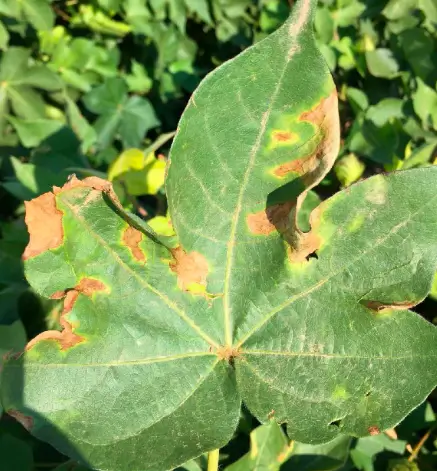
Tiger Claw Pattern: A unique symptom is a “tiger claw” or “tiger stripe” appearance on leaves, where the edges and areas between veins dry out first, leaving the veins green.
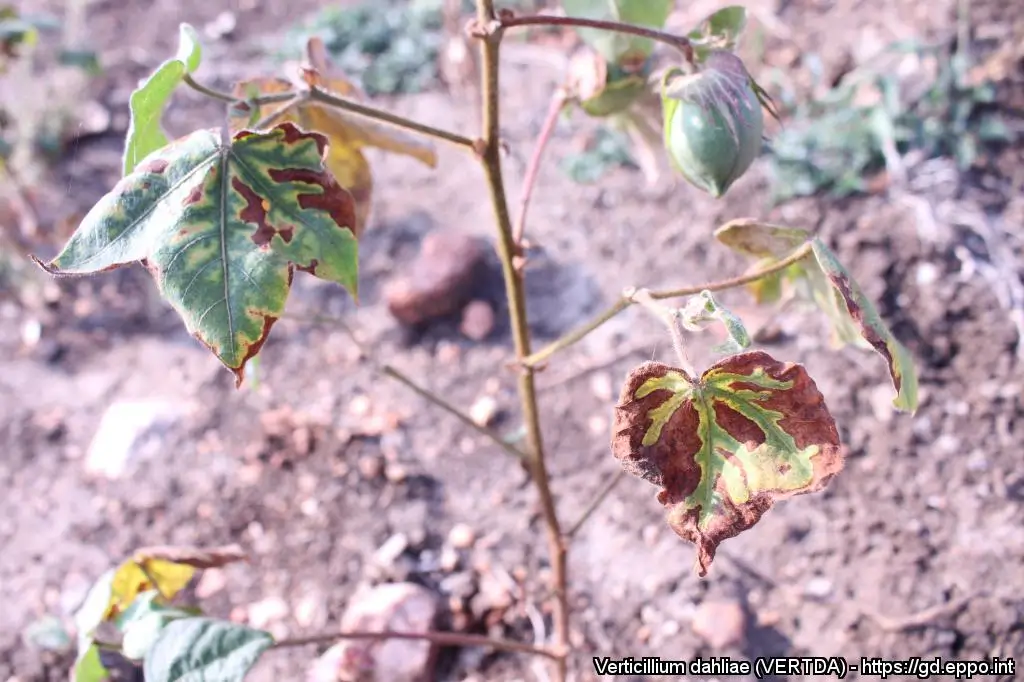
Uneven Distribution: Verticillium wilt symptoms may appear unevenly in the field, affecting individual plants or patches.
Symptoms generally appear after the first flowering, with younger plants often affected by Fusarium wilt, which can present similarly.
You can also observe bronzing of veins and can observe drying of margins.
How to manage Verticillium wilt in cotton?
- Rotate cotton with non-susceptible crops such as corn, wheat, barley, sorghum, safflower or rice. Following crop rotation helps in reducing fungus population in the soil.
- Plant cotton varieties that are tolerant to Verticillium wilt.
- If the disease pressure is high (more than 10 microsclerotia per gram of soil) and air temperatures are cool, delay the first irrigation to reduce disease severity.
Organic Practices to Manage Fusarium and Verticillium Wilt in Cotton
Seed treatment with Trichoderma viridae at the rate of 10 grams per litre of water. You can also apply Pseudomonas sp. at the rate of 2 ml per litre of water.
Chemical Practices to Manage Fusarium and Verticillium Wilt in Cotton
Chemical fungicides such as carbendazim at 2 grams per litre of water can be given as soil drenching. Azoxystrobin can be applied as a spray and also as drenching at the rate of 0.5-1 ml per litre of water. Mancozeb can be used as a spray at the rate of 2-2.5 grams per litre of water. Thiophanate-methyl can be applied as a foliar spray at the rate of 1 gram per liter of water and as drenching at the rate of 2-4 grams per litre of water.
Root Rot in Cotton
Cotton root rot, also known as Phymatotrichopsis root rot, Texas root rot, or Ozonium root rot, is a major fungal disease that wreaks havoc on cotton crops in specific regions.
The culprit behind root rot is the soilborne fungus Phymatotrichopsis omnivora. This villain has a wide host range, attacking over 2,000 plant species, except grasses (monocots).
The fungus grows in hot summer temperatures, typically above 28°C (82°F). This aligns with the cotton growing season in the affected regions with clay loam soils with a pH range of 7.0 to 8.5.
Unlike other two diseases, root rot can remain hidden for a while. The fungus initially colonises the roots, slowly restricting water and nutrient uptake.The first visible sign is often a sudden wilting of the plant. This can happen quickly, within 24-48 hours, after the initial bronzing of leaves.The wilting progresses rapidly, affecting all leaves from top to bottom. The plant dies quickly, often with leaves still attached.
Growing cotton after crops like vegetables, oilseeds and legumes, which are favorable hosts, increases the risk.
Wounds caused by nematodes and ash weevil grubs can also increase disease incidence.
Symptoms of Root Rot in Cotton
Root rot is one of the major fungal diseases in cotton which occurs in three phases: seedling disease, sore shin and root rot.
Seedling Disease

When it affects the seedlings, fungus causes black lesions on the hypocotyl of the germinating seedlings. This results in the girdling of the stem and the death of affected seedlings.
Sore Shin Stage
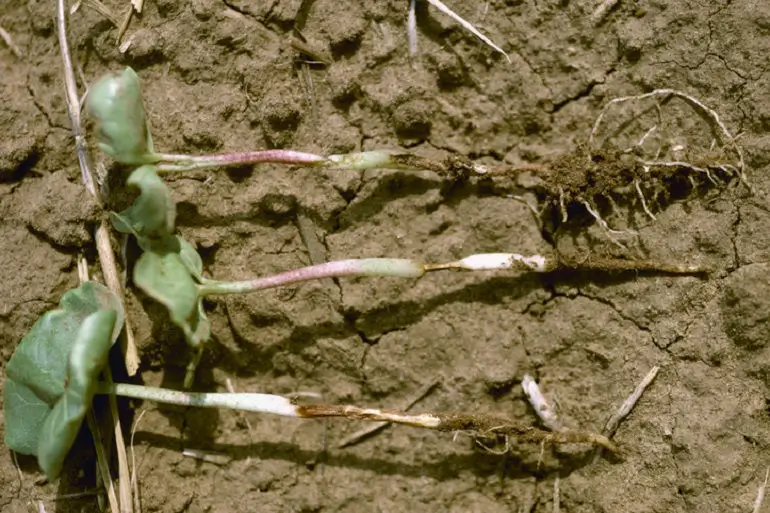
Dark reddish-brown cankers appear on the stem near the soil surface, eventually turning black. This leads to the drying up of plants and can break at the collar region, causing the entire plant to wither.
Root Rot
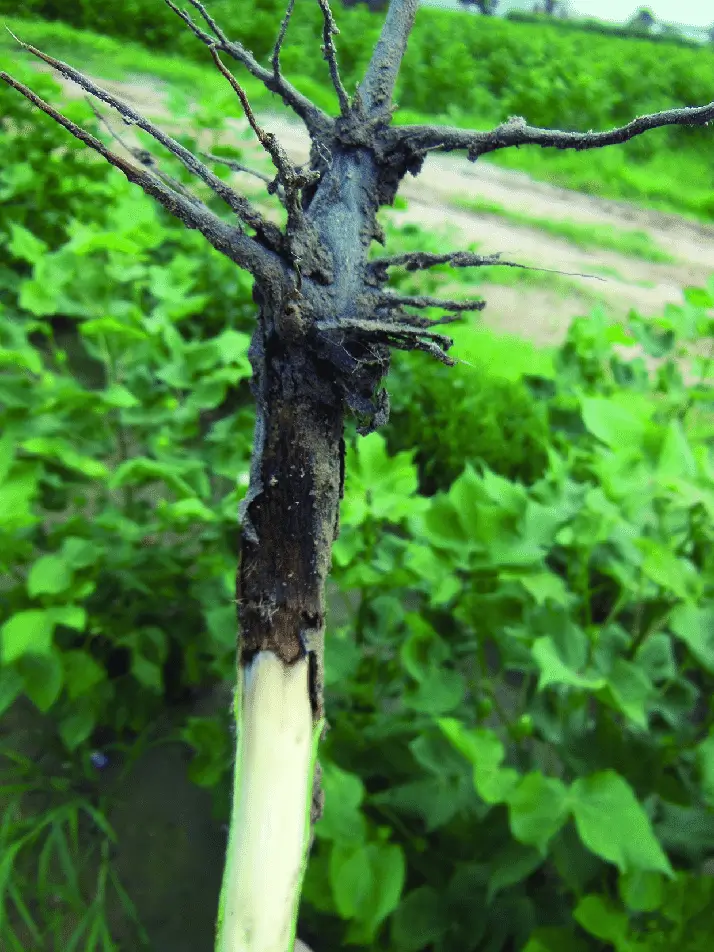
The bark of the affected plant shreds and may extend above ground level. You can observe dark brown sclerotia, which are the resting structures of the fungus, appear on the wood or the shredded bark. The entire root system becomes rotted, leading to plant desiccation and easy uprooting of the plant.
Managing Root Rot in Cotton
Effective management of root rot involves both biological and chemical methods:
Biological Management
- Apply Trichoderma viridae at the rate of 1-2 kg mixed with 100 kg of farmyard manure (FYM).
- Giving Pseudomonas fluorescens) for drenching at the rate of 10 gm per litre of water and if given as soil application, use 10-15 gm per litre.
Chemical Management
- Carbendazim can be applied at the rate of 0.5-0.75 gram per litre of water as drenching
- Apply Mancozeb + Carbendazim as drenching at 2.5-3 gm per litre of water.
Cultural Practices
- Summer ploughing is important to remove the infected plants and burn them
- Plant cotton in the first week of April or the last week of June to avoid peak disease periods.
- Intercropping with sorghum or moth bean (Phaseolus aconitifolius) to lower soil temperature.
Read for more Cotton Framing Tips, and expert advice.
Remember, early detection is key! By keeping a watchful eye on your cotton plants and taking quick action, you can minimise the impact of fungal diseases in cotton and ensure a healthy, fruitful harvest.
Hopefully, the practices we discussed will effectively address your Cotton Farming problems. However, always consult an expert before applying any chemicals.